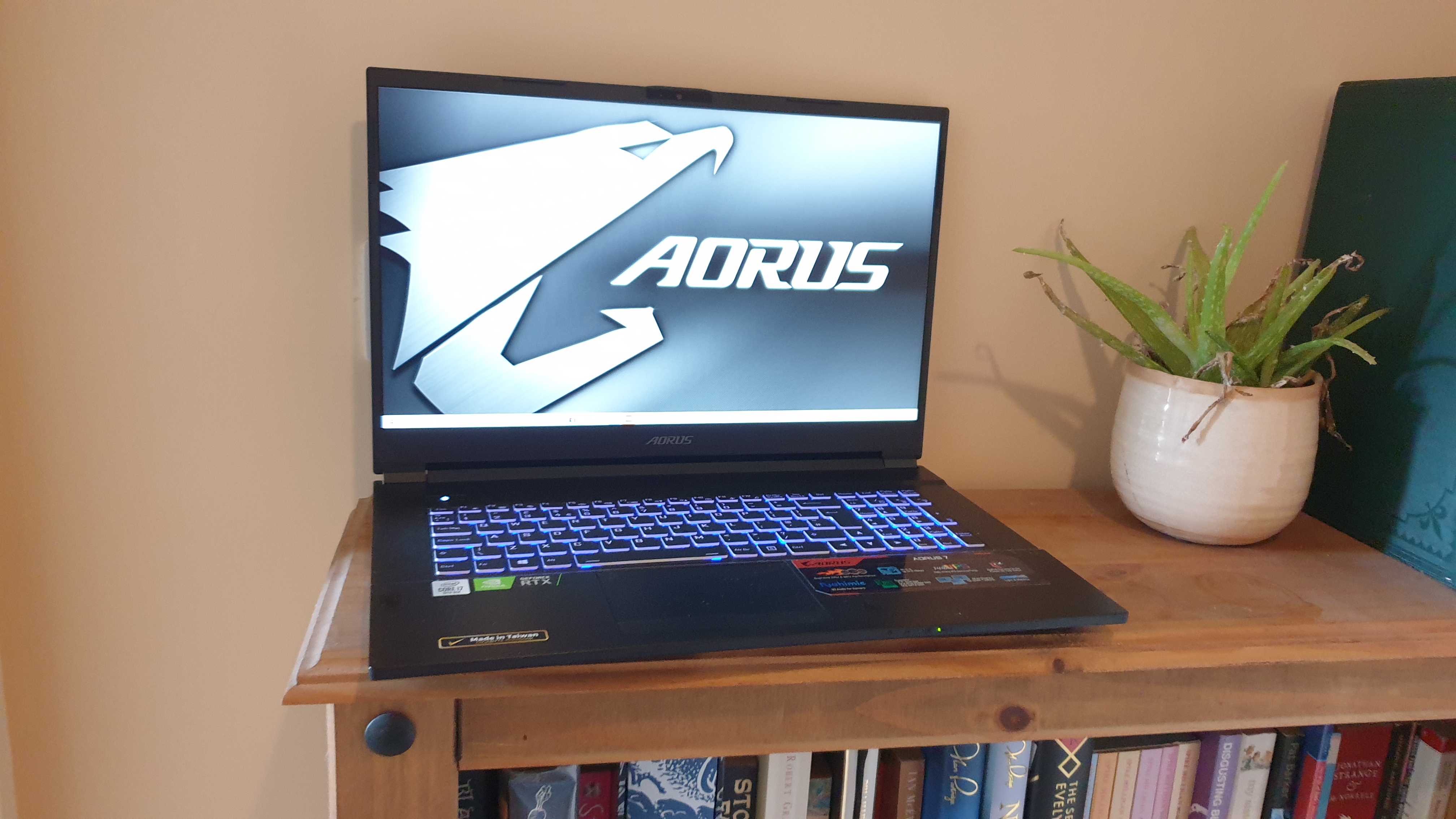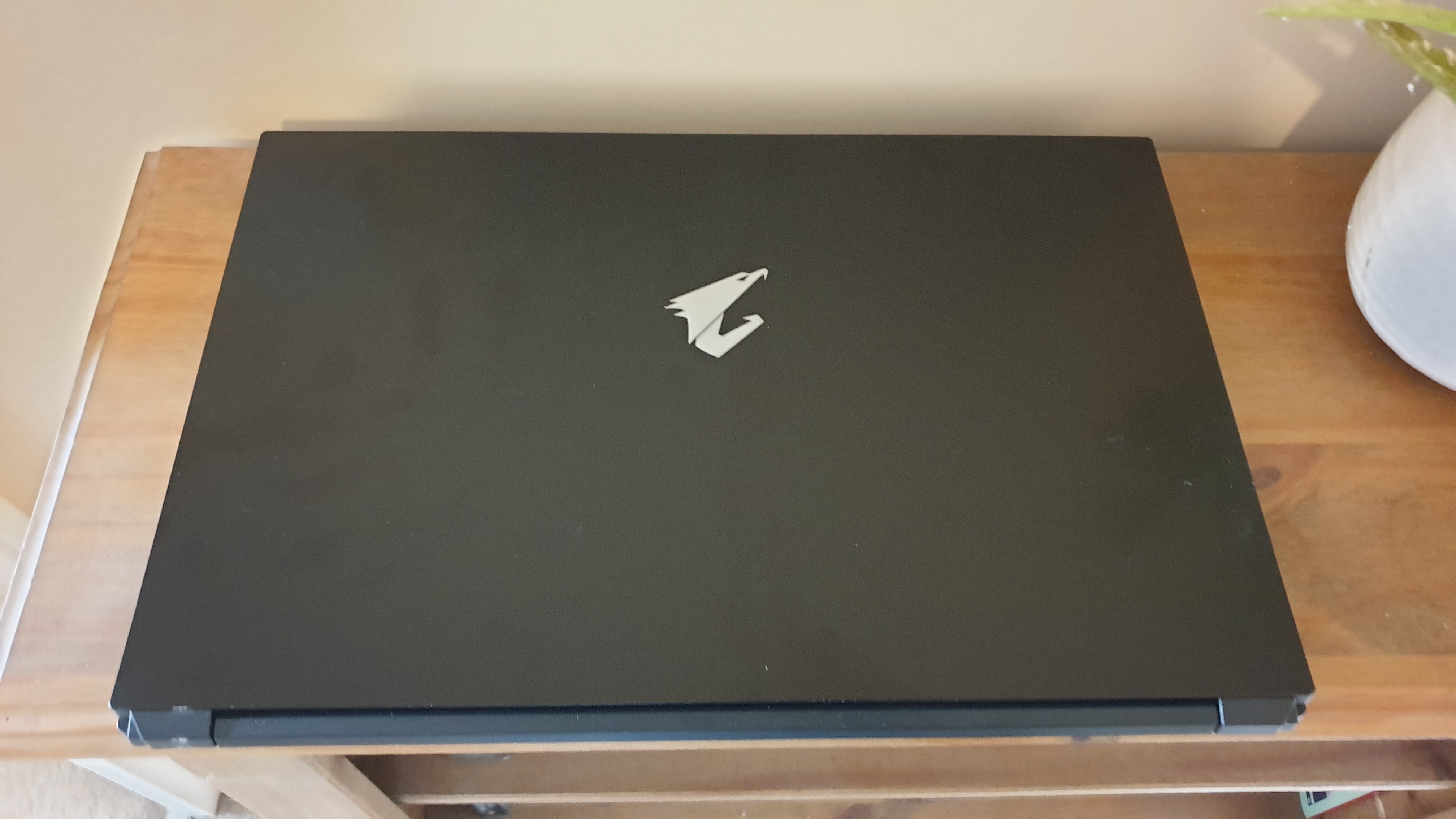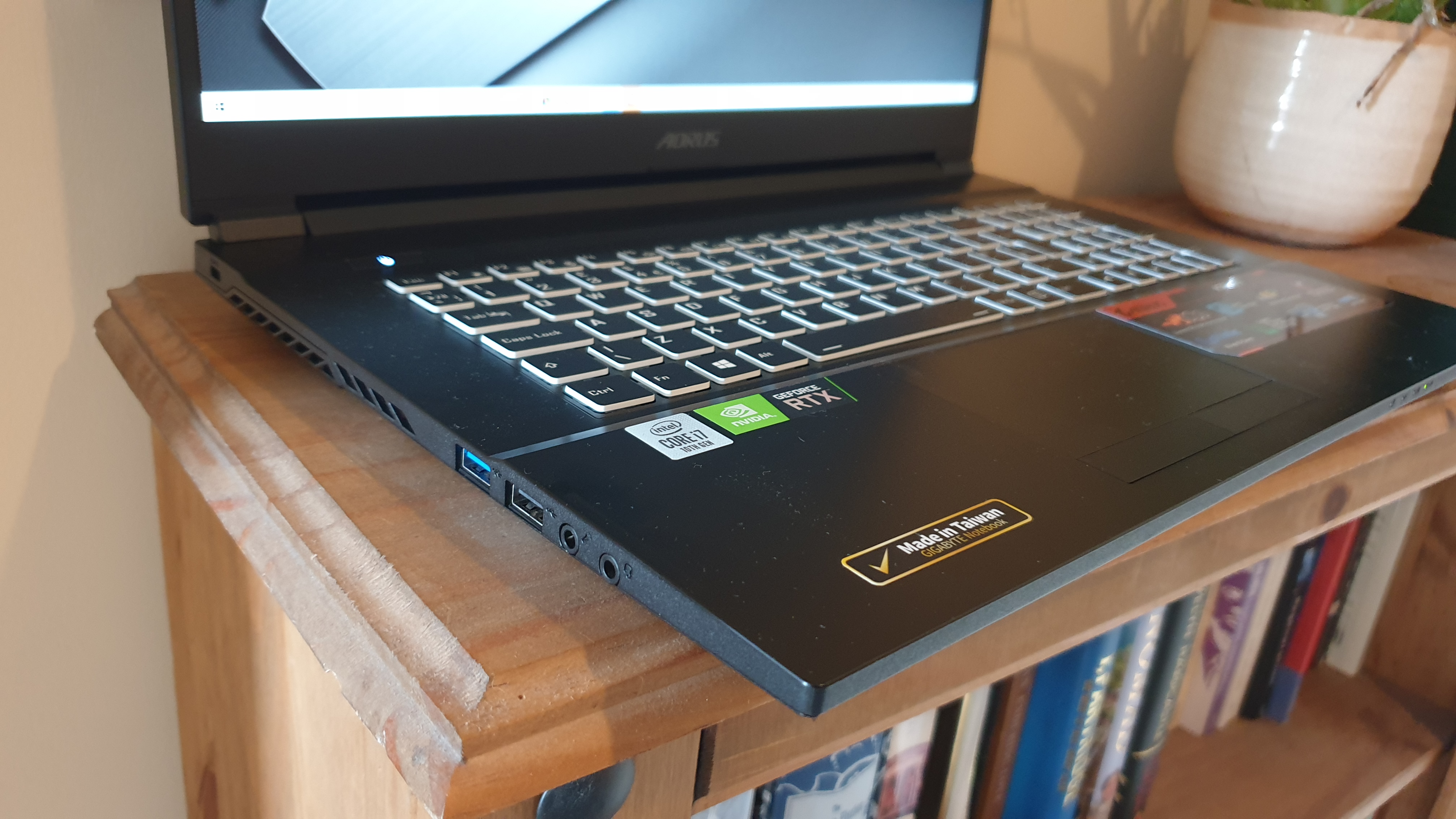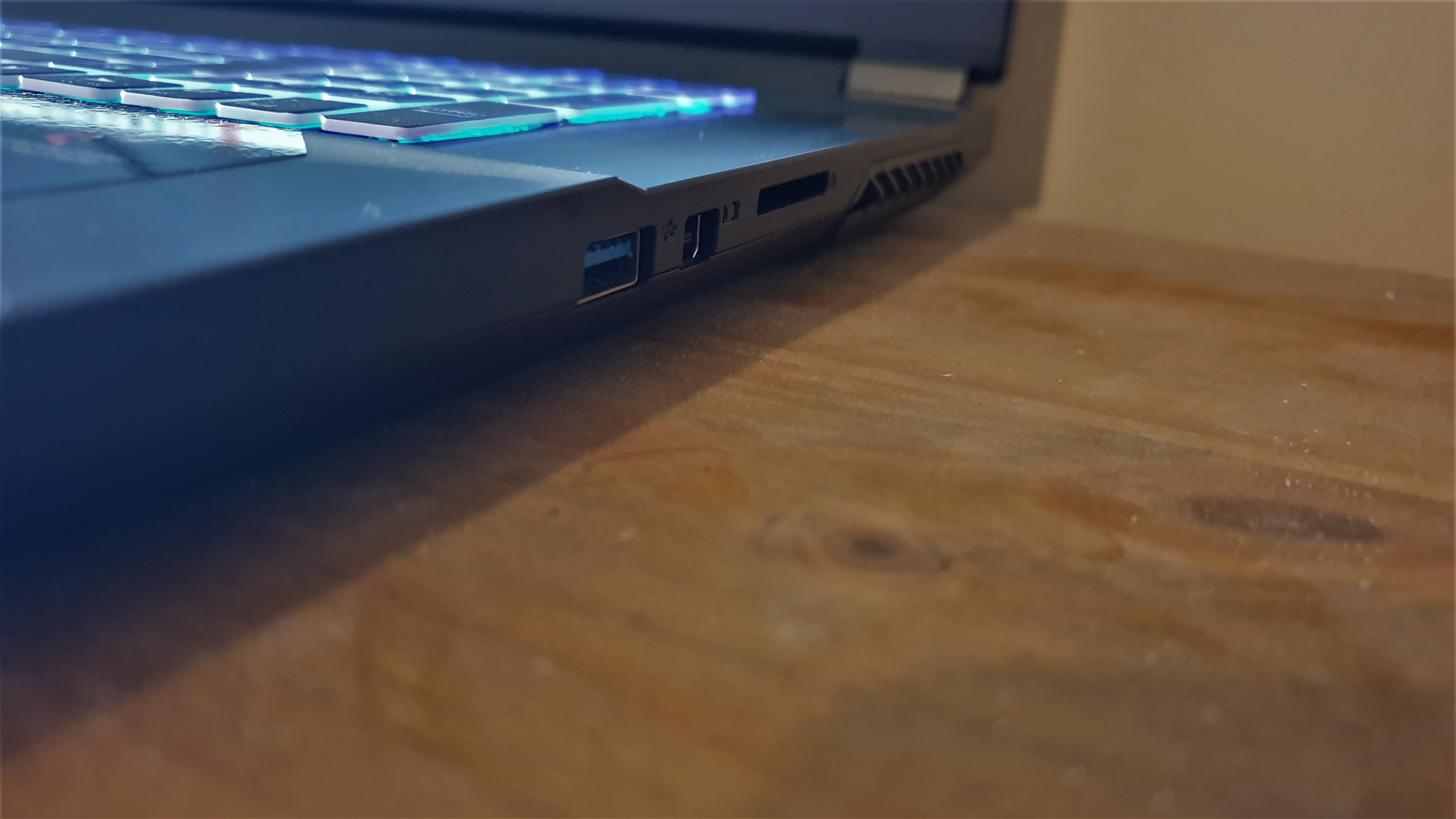TechRadar Verdict
The Gigabyte Aorus 7 is a great example of a mid-range gaming laptop that gets the balance between price and performance just right. For 1080p gaming, this is an excellent, and affordable, gaming laptop.
Pros
- +
Good price
- +
Very good performance
- +
144Hz screen
- +
Replaceable battery
Cons
- -
Fans get loud
- -
Design is nothing to get excited about
- -
Keyboard and touchpad keys have shallow travel
Why you can trust TechRadar
Two-minute review
The Gigabyte Aorus 7 is a gaming laptop that is pitched at perhaps the hardest market to get right: the mid-range.
So, unlike high-end gaming laptops that can throw the latest and greatest components together in a bid to attract gamers with plenty of money to spend, or budget gaming laptops that can make wise cuts that are justified as long as the price is low enough, mid-rangers like the Gigabyte Aorus 7 have to balance the two.
That means the Gigabyte Aorus 7 needs to offer a step up when it comes to performance, features and build quality, while also keeping the price at a level that won’t be prohibitively expensive for many people.
It’s a tricky balancing act, and one which many devices sadly fail at. However, with our time with the Aorus 7, we're pleased to report that Gigabyte has pretty much managed to pull it off.
First, there's the price. The model we got in comes with a a new 10th-generation Intel Core i7 processor, 16GB of RAM and an Nvidia GeForce RTX 2060 for $1,599/£1,599 (around AU$2,300).
That's a decent spec for the price, and it means most modern games will run without an issue, and you'll also get ray tracing goodness. The screen is a 1080p 144Hz affair, and again that proves a wise choice, as it looks great without taxing the GPU too much.
The overall performance of the Gigabyte Aorus 7 is very good, in fact, and we played graphically intensive games like Metro Exodus at high graphical settings and perfectly playable frame rates. With the demanding ultra settings of Metro Exodus, the Gigabyte Aorus 7 scored a pretty respectable 44fps. With a few tweaks here and there – remember, gaming on a mid-range device is a balancing act – you can get some excellent gaming results on this laptop without having to spend a fortune.
Battery life is also pretty impressive for a gaming laptop, and will go a whole work day without needing a charge – as long as you stick to rather undemanding tasks.
It's not a complete success, however. The design is a little bland, and when the fans kick in, this thing gets noisy. However, overall, the Gigabyte Aorus 7 is a fantastic mid-range gaming laptop that offers gamers a chance to experience some of the best PC games without breaking the bank.

Price and availability
Here are the specs of the Gigabyte Aorus 7 sent to TechRadar for review:
CPU: 2.6GHz Intel Core i7-10750H (6-core, 16MB cache, up to 5GHz)
Graphics: Nvidia GeForce RTX 2060 (6GB GDDR6)
RAM: 16GB DDR4 (2,933MHz)
Screen: 17.3-inch Full HD (1,920 x 1,080) IPS, 144Hz
Storage: 512GB SSD (PCIe), 1TB HDD
Ports: 1 x USB 2.0, 2 x USB 3.2, HDMI 2.0, Mini DisplayPort 1.2, 1 x USB-C, 1 x audio combo jack, 1 x microphone jack, 1 x SD card reade
Connectivity: LAN, Wi-Fi 6, Bluetooth 5.0
Weight: 5.51 pounds (2.5kg)
Size: 15.55 x 10.23 x 1.14 inches (395 x 260 x 29 mm; W x D x H)
Getting the price right is almost as important for a mid-range laptop as it is for a budget one, and the Gigabyte Aorus 7 does a pretty good job.
For model we’ve reviewed (the Gigabyte Aorus 7 KB), you get a new 10th generation Intel Core i7 processor, 16GB of RAM and an Nvidia GeForce RTX 2060 for $1,599/£1,599 (around AU$2,300).
That’s a pretty fair price for a laptop that features Nvidia’s entry level RTX card, so you’re getting features like ray tracing, as well as an IPS 144hz gaming screen. It’s cheaper than the Razer Blade 15 with similar specs and a bit more expensive than the Lenovo Legion Y740, which certainly puts it in good company. These are laptops we like a lot.
Also, it has a newer CPU than the Legion Y740, making that slight increasing in price worthwhile.
If that’s still a bit too much, there’s also the Aorus 7 SB, which swaps the GPU for the Nvidia GTX 1660 Ti. This is a modern, budget, Nvidia GPU that doesn’t come with RTX-exclusive features like ray tracing. If you can live without those, then you should get a decent saving – it’s being sold in the UK for $1,499/£1,299 (around AU$2,140).

Design
The design of the Gigabyte Aorus 7 is rather restrained for a gaming laptop, and is similar to the cheaper Aorus 5. So, you get an all-black body and a simple silver Aorus logo on the back. On either side of the laptop are vents for the fans, and they suit the design well.
While some may think this is a bit of a boring design, others will like the fact that it doesn’t throw it’s ‘gamerness’ in your face. The Aorus 7 has enough oomph to be a pretty decent creative workstation, and its understated design means you could use it for productivity work without it looking out of place in an office or a studio.
Unfortunately, another thing that the Aorus 7 borrows from the Aorus 5 is the plastic material the chassis is made from. This gives the laptop a bit of a cheap and brittle feel. We weren’t fans of it with the Aorus 5, but as it was cheaper, we could understand Gigabyte’s reasoning. However, with the more expensive Aorus 7, the cheap feel is harder to justify.
It’s certainly clear that this isn’t a premium laptop, but for many gamers, it’s not about the aesthetics, but about how well the laptop can play games, that matters.
The dimensions of the Gigabyte Aorus 7 are 15.55 x 10.23 x 1.14 inches (395 x 260 x 29 mm) and it weighs 5.51 pounds (2.5kg), which, impressively, isn’t that much larger than the 15-inch Aorus 5’s dimensions (14.21 x 10.15 x 1.09 inch (361 x 258 x 27.9 mm)). This is in part thanks to the thin bezels that surround the larger 17-inch screen.
As far as some gaming laptops go, these dimensions are on the thinner side – but this is still a laptop that isn’t the easiest to carry around with you.
Port selection is good, however, with a USB 3.2, mini display port and SD card reader on the right-hand side of the laptop, and an audio jack, microphone jack and USB 3.2 and USB 2.0 ports on the left.
On the back of the laptop you’ll find a USB-C port, HDMI and a Ethernet port (plus port for plugging in the power adapter). Overall, it’s an excellent selection of ports that covers pretty much everything a gamer needs – and that SD card reader means it’s also a decent choice for creatives like photographers.

On opening the laptop, you’re presented with an LED-backlit keyboard with decently-sized keys that feel a little soft when in use. This is due to the shallow travel, and it means there’s not the kind of tactile responsiveness we’ve come to love on some keyboards.
That shallow travel strikes the touchpad’s left and right buttons as well. They move so slightly when pressed that it can sometimes feel like you’ve not correctly pressed it. It’s a shame, as the trackpad itself is otherwise fine. It’s at least multi-touch, so you can get around using the buttons by tapping it with a single finger to left-click, and tap it with two fingers for a right-click.
The power button is on the top-left of the keyboard, and there’s no biometric login features like a fingerprint scanner. This won’t be high up on most people’s list of essentials, but it’s a feature we’re seeing in an increasing number of modern laptops.
Then, of course, there’s the screen. At 17.3-inches that’s surrounded by thin bezels, it’s certainly an eye-catching feature Gigabyte claims there’s an 86% screen to body ratio with the Aorus 7. It supports up to 72% of the NTSC color gamut, and while that probably won’t be enough for creative professionals, it does help images look more vibrant – and accurate – on this screen.
It’s also got a 144Hz refresh rate and 5ms response time, which is great for fast-paced games. The screen is full HD (1080p), which is a good compromise considering the price of the laptop and the power of the GPU included. The RTX 2060 should be able to handle most modern games without too many issues at 1080p – and it means reaching high frames per seconds (for taking advantage of the 144hz refresh rate) is a lot easier.
Performance
Here's how the Gigabyte Aorus 7 fared in our suite of benchmark tests:
3DMark Night Raid: 34,958; Fire Strike: 13,943; Time Spy: 5,879
Cinebench R20: 2,514 cb
Geekbench 5 Single-Core: 1,260; Multi-Core: 6,105
PCMark 10 Home: 5,071
PCMark 10 Battery Life: 4 hours 1 minutes
Battery Life (TechRadar movie test): 6 hours 29 minutes
Total War: Three Kingdoms: 142fps (1080p, Low) 47fps (1080p Ultra)
Metro Exodus: 135fps (1080p, Low), 44fps (1080p, Ultra)
The Gigabyte Aorus 7 sent to TechRadar comes with a new Intel Core i7-10750H processor, which is a six core, 12 thread CPU with a base frequency of 2.60GHz and a max of 5GHz. That’s a pretty decent CPU for pretty much any daily task you want of the laptop, and with a TDP of 45W, it’s a mobile processor that does a good job of balancing performance versus sucking up too much battery life. And, as we said before, balance is key with a mid-range gaming laptop.
The Nvidia GeForce RTX 2060 is also a great pick, we think, for the price range, and paired with the 1080p 144Hz screen, it should handle most modern games with ease.
Take Metro Exodus, which remains one of the most graphically-impressive PC games, and is a great showcase for ray tracing. As we mentioned, the RTX 2060 is the most affordable way to get ray tracing, and it means owners of this model of the Gigabyte Aorus 7 get to experience impressively life-like lighting effects without paying a huge premium for it.
Our benchmark results point to a gaming laptop that does a pretty great job of punching above its weight. With the demanding ultra settings of Metro Exodus, the Gigabyte Aorus 7 scored a pretty respectable 44fps. That’s well above the 30fps many people consider to be the absolute minimum for a playable experience. It also beats the 38fps the similarly-priced Asus Zephyrus G14 scored, and that’s our current pick for the best gaming laptop in the world.
Essentially, for the price you’re able to play one of the best looking games at ultra settings with ray tracing and frame rates easily past 30fps. We ended up playing it with the ‘Extreme’ settings turned on, along with ray tracing, and even then, the Gigabyte Aorus 7 put in a decent performance. With a bit of tweaking, you’ll get a mix of graphics and performance that you should be very happy with. Again; balance.
The same can be said for the Gigabyte Aorus 7’s performance in Total War: Three Kingdoms. This real time strategy game with hundreds of units on screen at once is a CPU-intensive game (while still giving the GPU a good workout), and the Intel-based Aorus 7 again produces better results than the Asus Zephyrus G14, which comes with an AMD processor in the unit we tested.
The screen of the Gigabyte Aorus 7 puts in a good showing as well. The 17.3-inch size is nice and big, and while 1080p isn’t the highest of resolutions for PC gamers these days, games still looked great on it, and that full HD resolution allows the laptop to hit high frame rates. Pairing a 4K screen with an RTX 2060 would be a bit of a futile gesture for most games.
When playing fast-paced multiplayer competitive games, like Fortnite, the 144Hz panel really shines, offering fast and fluid gameplay. Along with the excellent performance, built-in LAN and relatively portable design, the Gigabyte Aorus 7 is an excellent choice for esports players.
While we were overall very impressed with the gaming performance of the Gigabyte Aorus 7, we have to note that this laptop gets very loud when working hard. This is often the case with compact laptop designs with powerful components inside, and while Gigabyte should be commended for keeping the Aorus 7 cool – we didn’t notice any throttling of performance due to high temps in our use – the combination of two fans with 47 blades each and three air vents can result in pretty distracting noise.

Battery life
Battery life is often the biggest compromise gaming laptops make, and it’s here that mid-rangers like the Aorus 7 have an upper hand over more powerful and expensive devices. Because the hardware within the Aorus 7 is more sensible, it means it’s less power hungry, and that can help keep the battery going longer.
In our tests, we found the Aorus 7 lasted an impressive six and a half hours with a looped 1080p video. While that’s not a long battery life for a standard laptop, its not bad at all for a gaming laptop, and it means you can use it without it being plugged in for a few hours at least.
However, when it comes to gaming, which is far more intensive, the laptop’s not going to last quite as long.
Oh, and one thing we should commend Gigabyte on – the Aorus 7 has a replaceable battery. Not only does this mean that you could be additional batteries to keep the laptop going while out and about (though you’d need to turn off the laptop before you swapped the batteries), it means over time, as the original battery become less adept at holding its charge, you can buy a new battery, rather than have to replace the whole laptop.
Software
The Gigabyte Aorus 7 comes with Windows 10 Home preinstalled, and thankfully very little other software. Laptop makers often include trials of software as a way to increase their margins, and while this can sometimes result in a cheaper laptop, it more often means you get a machine full of software you don’t want, and which often nags you to upgrade once the trial period ends.
So, it’s to Gigabyte’s credit that the Aorus is largely free of that. There are preinstalled Gigabyte apps, such as the Aorus Gaming Center, which is an easy to use bit of software that lets you choose between power profiles (so, giving your components a bit more oomph when gaming), as well as tweak the keyboard RGB lighting and assign new keymaps.
It’s straightforward and easy to use, and is one of the better preinstalled bits of software we’ve seen.
Buy it if...
You love esports
The excellent 144Hz 1080p screen and very good performance makes this an excellent laptop for people who love playing competitive multiplayer games.
You want ray tracing without the big price tag
The RTX 2060 is the ideal choice for a mid-range gaming laptop, bringing ray tracing and other RTX-exclusive features to more affordable devices.
You want a bit of future proofing
While the Gigabyte Aorus 7 doesn’t feature the most cutting edge components, it offers a level of performance that will allow you to play AAA games for years to come with a few choice tweaks to the graphics. Also, it lets you swap out the battery, giving it a degree of future proofing other laptops lack.
Don't buy it if...
You want 4K action
The Aorus 7’s screen is only 1080p, which is a wise choice considering the specs. Even if you plugged the laptop into a 4K TV or monitor, the RTX 2060 won’t be able to hit 4K at playable framerates for many games.
You want a bit a pizazz
The design of the Aorus 7 is rather simple for a gaming laptop. While that may appeal to some people, others could accuse it of being boring.
You like silence
There’s a lot to like about the Aorus 7, but we have to warn you, this thing’s fans are loud when you’re gaming – to the point where they can be quite distracting. If this is a deal breaker, look elsewhere – or invest in a gaming headset.
- These are the best laptops

Matt is TechRadar's Managing Editor for Core Tech, looking after computing and mobile technology. Having written for a number of publications such as PC Plus, PC Format, T3 and Linux Format, there's no aspect of technology that Matt isn't passionate about, especially computing and PC gaming. He’s personally reviewed and used most of the laptops in our best laptops guide - and since joining TechRadar in 2014, he's reviewed over 250 laptops and computing accessories personally.
